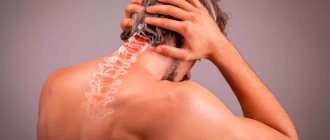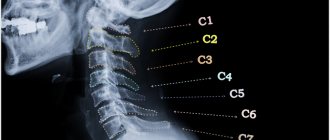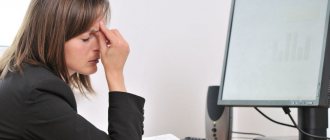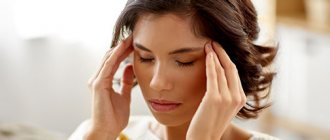The problem of treating patients who have suffered a spinal cord injury is one of the most difficult in the neurorehabilitation system. Such patients are psychologically and/or economically dependent on their loved ones and on society, since their movements are often significantly limited and the natural functioning of vital body systems is disrupted [1, 2].
Numerous modern studies have demonstrated great promise for the use of electrical stimulation of the spinal cord in motor rehabilitation of patients with long-term consequences of spinal cord injury. It has been proven that several years after the injury, after complete paralysis, patients can stand and walk independently after a course of rehabilitation using epidural electrical stimulation of the spinal cord [3-5]. It has been proven that the mechanism of action of epidural and transcutaneous electrical stimulation of the spinal cord (TESCS) is the same [6]: TESC, as well as epidural electrical stimulation, can be successfully used to restore the motor functions of patients paralyzed after a spinal cord injury due to its complete motor damage [7 -9].
A feature of most previous works that showed the capabilities of electrical stimulation of the spinal cord in restoring voluntary movements and independent maintenance of a vertical posture is that regular, often daily, stimulation effects and accompanying motor training lasted 5-9 months and all motor training was carried out by the efforts of 2- 3 methodologists in the presence of a physiologist or doctor [4, 5, 10]. That is, impressive results were achieved over a long period of time with the involvement of a large number of specialists. In fact, the vast majority of work in this area are expensive scientific studies conducted under specific experimental conditions on patients selected in accordance with the requirements of a particular study. It remains unclear how effective a course of electrical stimulation of the spinal cord is in restoring the motor activity of patients who have suffered a spinal cord injury outside of the limitations and experimental conditions.
Spinal cord injury is accompanied not only by motor impairments. It is important to evaluate the effectiveness and safety of electrical spinal cord stimulation procedures primarily for restoring bladder, bowel and sexual function in patients with spinal cord injury, since the greatest suffering in spinal patients is caused by violations of these functions [11]. Spinal cord stimulation with parameters used to restore motor function has previously been shown to affect urinary function [12, 13]. Recently published results of a urodynamic study showed that in patients with spinal cord injury who do not control bladder function, a single tESCS at the level of the Th11-12 vertebrae reduces detrusor overactivity, regulates detrusor-sphincter mismatch, increases bladder filling and facilitates urination [14]. Thus, it can be expected that a short-term course of electrical stimulation of the spinal cord, aimed at restoring motor activity, can have a positive effect on the rehabilitation of excretory functions.
The purpose of the study is to determine the effectiveness of using tESCS in combination with standard rehabilitation of patients who have suffered a spinal cord injury. An additional goal is to evaluate the effect of tESCS on excretory functions in patients with spinal cord injury.
Material and methods
The studies were carried out on the basis of St. Petersburg State Budgetary Healthcare Institution “City Hospital No. 40”. The purpose, objectives and protocol of the study were approved by the scientific problem committee (protocol No. 142). Informed written consent to participate in the study was obtained from patients.
Inclusion criteria for the study: age over 18 years, mid- and lower-thoracic level of injury, duration of injury more than 9 months, severity of spinal cord injury according to the American Spinal Injury Association (ASIA) scale - B or C, muscle tone of the lower extremities on the modified Ashworth scale - 2 or 3 points.
Exclusion criteria: severe concomitant diseases in the stage of decompensation, damage to the skin in the area where the electrodes are located, the presence of instability in the elements of the musculoskeletal system, mental illness.
The study involved 15 patients with late-stage spinal cord injury (Table 1;
Table 1. Description of study participants. Changes in motor activity indicators before and after treatment Note. * — patients underwent rehabilitation on an outpatient basis. Female patients are in italics, differences in indicators before and after the course of treatment are in background, positive dynamics are in bold, and negative dynamics are in regular font. patients are ranked within each group according to the duration of the period after injury). All patients underwent a standard course of rehabilitation treatment. The rehabilitation course consisted of physical therapy classes, mechanotherapy, including robotic therapy (Lokomat, Hocoma, Sweden), massage, and physiotherapy, performed daily, 10 procedures per course. The duration of the study was ~2 weeks.
The main group (Nos. 1-7 in Table 1) consisted of patients who agreed to undergo the TESCM procedure. They received a standard course of therapy and TESCM procedures. Patients in the control group (nos. 8-15 in Table 1) received only standard treatment.
The BioStim-5 device (Kosima LLC) was used for ESSM. Electrodes (WFB02 QWER, China; BF4, LEAD-LOC, Inc., USA) with an adhesive conductive layer were fixed cutaneously. A stimulating electrode (cathode) in the form of a disk with a diameter of 2.5 cm was placed on the midline of the spine between the spinous processes at 3 levels: C5-6, Th11-12 and L1-2. Indifferent electrodes (anodes) were placed symmetrically over the iliac crests. Stimulation was carried out by rectangular pulses (monopolar and/or bipolar) with a duration of 1 ms, filled with a carrier frequency of 10 kHz. The magnitude of the current was selected individually so that it was not painful and at the same time caused contraction of the muscles of the lower extremities. The amplitude range of the currents used was 30–120 mA. During the procedure, the current value was gradually increased by 20-40 mA. The pulse frequency was 15–30 Hz. TESSM was carried out simultaneously with motor training on a simulator for active-passive rehabilitation of the upper and lower extremities (Thera vital, “Medica Medizintechnik”, Germany). The training regimen was selected individually depending on the functional abilities of the patients and the assigned rehabilitation tasks. Also, to improve statics, exercises were used while sitting on a chair, standing in a knee support with a gradual decrease in the area of support. When choosing the parameters of stimulating effects, we were guided by the results of using tESCS to regulate locomotor [8] and postural functions [10] in patients with vertebrospinal pathology.
The duration of the complex procedure was 30 minutes; there were 10 procedures per course, performed daily, 5 times a week.
Standard scales were used to assess the neurological status of patients before and after the course of treatment. To determine the severity of spinal injury in terms of sensitivity and muscle strength, the ASIA/ISNCSCI scale (International Standards for Neurological and Functional Classification of Spinal Cord Injury) was used. The Ashworth scale was used to determine muscle spasticity. The strength of the flexor and extensor muscles of the hips, legs and feet was assessed using the 6-point British Medical Research Council scale (Harrison scale) [15]. Also, the standard neurological examination included determining the level of hypo- and anesthesia, the presence of deep sensitivity and muscle-articular sensation. Patients filled out a urination diary, in which they noted the urge to urinate and its control. The amount of residual urine was monitored using bladder catheterization or ultrasound. All studies were carried out before the start of the rehabilitation course and immediately after its completion.
Statistical analysis of changes in muscle strength and sensitivity was performed using Student's t test and the nonparametric Wilcoxon test, comparing values for both legs of the patient without averaging them. Differences between indicators were considered statistically significant at p
<0.05 for each criterion. Other indicators were compared using the Mann-Whitney or Wilcoxon tests.
Spinal cord stimulation: a neuromodulation method of influencing the activity of the nervous system
Spinal cord stimulation is one of the effective methods for managing “difficult” pain and refers to neuromodulation methods of influencing the activity of the nervous system.
Neuromodulation methods are minimally invasive surgical interventions that involve electrical and/or neurotransmitter stimulation of various parts of the nervous system. Methods of electropulse stimulation of the posterior columns of the spinal cord, developed and introduced into clinical practice in the 70s of the last century, opened up new possibilities for pain therapy. Using chronic electrical stimulation, it is possible to obtain the desired clinical effects without destroying tissue, i.e. this technique is fundamentally different from previously used destructive procedures, such as neurotomy, rhizotomy, myelotomy, etc.
The technology of chronic epidural stimulation of the posterior columns of the spinal cord has been used in the world for 30 years. In our country, the frequency of use of this effective method in the treatment of pain still remains low.
The term "difficult" pain is not strictly academic. However, it is often used in scientific articles discussing conservative and surgical treatments for chronic pain. This term is even included in the title of a brilliant monograph by Russian authors on functional neurosurgery, which was recently published. By “difficult pain” we mean chronic drug-resistant neuropathic pain syndrome.
Neuropathic pain has a clear definition adopted by the International Association for the Study of Pain. This is pain caused by damage to one or another part of the nervous system. This type of pain has a number of signs and symptoms that are well known and described by different authors: allodynia (painful reaction to a non-painful stimulus), mechanical and/or thermal hyperalgesia (excessive response to a painful stimulus), hyperpathia (increased pain to repeated irritation).
Neuropathic pain is also characterized by autonomic disorders (decreased local tissue perfusion, hyper- and hypohidrosis, local osteoporosis). In addition, neuropathic pain can intensify with psycho-emotional stress.
Taking conventional analgesics, as a rule, does not bring relief to patients suffering from neuropathic pain syndromes. Anticonvulsants and antidepressants affect neuropathic pain, but they often do not bring relief and have significant side effects.
When the pain process becomes chronic, neuropathic pain itself becomes a “disease,” often regardless of the initial etiological factor. Thus, the general indication for the use of the spinal stimulation method was the presence of a long-term neuropathic pain syndrome in the patient, resistant to various types of conservative treatment (medicines, drug blockades, physical therapy, acupuncture, psychotherapy).
When we began treating this group of patients, we were clearly aware that we were entering the field of palliative medicine, since we would not be able to radically relieve long-term patients from intense pain. Our goal was to improve the quality of life of patients with neuropathic pain, i.e. try to help them effectively “manage” their pain.
During the period from February 2007 to April 2010, 62 patients with various neuropathic pain syndromes were operated on. More than half of the total number of patients (42 patients) had previously undergone surgery for lumbar degenerative compression syndromes.
Other nosologies are represented by benign spinal tumors (5 patients), nerve injuries (5 patients), traumatic disc herniations at the mid-thoracic level (two patients), two patients with the so-called. “level” pain in lower paraplegia as a result of spinal cord injury at the lumbar level, 3 patients with the so-called. post-surgical syndromes (1 after thoracotomy, 2 after herniotomy with clinical signs of damage to the p. Illioingvinalis), 2 patients with diabetic polyneuropathy and 1 patient with obliterating atherosclerosis of the lower extremities after a series of shunting and revascularizing vascular interventions.
All patients, with the exception of patients with diabetic polyneuropathy, had been previously operated on several times for the underlying disease. All patients received long-term treatment from doctors of various specialties (neurosurgeons, neurologists, physiotherapists). In all patients, the use of conservative treatment methods and further surgical operations were unsuccessful.
results
The average age of patients in the control group was 27.9±3.80 years, in the main group - 29.9±8.07 years. The average period after injury was 2.8±2.21 and 1.9±1.06 years in the control and main groups, respectively. There are no statistically significant differences between the groups in these parameters. Spasticity scores in the control and main groups were 2.7±0.39 and 2.1±0.35 points on the Ashworth scale, respectively. Initially, according to the scores of muscle strength, sensitivity, and recorded indicators of the urinary system, the groups were homogeneous among themselves and did not have statistically significant differences (see Tables 1 and 2).
Table 2. Changes in sensitivity and excretory function before and after treatment Note. * — 0 — no control, 1 — partial control, 2 — full control; ** - 0 - >100 ml, 1 - 50-100 ml, 2 - <50 ml. The differences in indicators before and after the course of treatment are highlighted in background, positive dynamics are in bold, and female patients are in italics.
During the rehabilitation treatment, no adverse events (illnesses, injuries, unplanned surgical interventions, etc.) occurred. There was an increase in spasticity by 1 point at the end of the course in 1 patient from the main group (O8) and 2 patients from the control group (K5, K9).
According to the results of the study of muscle strength, all patients of the main group, in whom muscle strength in the lower extremities was recorded at the beginning of the course, noted its improvement to 2-3 points (patients O5, O8, O10, O12), in 2 more patients who had previously had no muscle activity in the lower extremities, muscle strength appeared up to 2 points (patients O2, O4). Subjectively, patients noted that during the TESCM procedure it was easier for them to exercise on the simulator, stand or perform other doctor’s tasks, they began to feel tension and work of the muscles of the lower extremities, their regulation improved, which significantly influenced the emotional mood of the patients and further motivation to exercise.
In the control group, 1 patient whose muscle strength was recorded at the beginning of the course also showed an increase to 2 points (patient K10).
Comparison of muscle strength scores recorded before and after the course using statistical criteria revealed in the main group a significant increase in the strength of the flexor and extensor muscles of the hip and extensor muscles of the leg ( p
<0.05 by both Wilcoxon and Student's tests).
Statistical analysis of changes in muscle strength in the control group showed a significant increase in the strength of the hip flexor and extensor muscles according to the Wilcoxon test ( p
<0.01) and non-significant according to the Student test (
p
= 0.838). Due to the striking differences between the probabilities calculated using the 2 criteria, no conclusion was made about the statistical significance of the changes in muscle strength in the control group.
When studying sensitivity (see Table 2), in 1 patient of the main group the level of anesthesia dropped by 1 segment. Another 2 patients developed deep sensitivity and muscle-articular sensation in the knee joints (patients O2, O10). Comparison of sensitivity scores recorded before and after the course using statistical tests did not reveal significant differences.
In the control group, no change in sensitivity was noted after the course.
The increase on the ASIA scale in the main group ranged from 1 to 8 points. Patients O2 and O4 were reclassified the level and severity of injury on this scale from B to C (see Table 1).
The increase on the ASIA scale in the control group did not exceed 1 point.
After analyzing the urination diaries kept by the patients, it was revealed that in the main group, 1 out of 3 patients who did not control urination developed the urge to urinate, and he also regained partial control of urination (patient O2). Another 1 patient (O3) also developed partial urinary control. In both cases, the effect of TESCM on urinary function was noted after 3-5 procedures. At the beginning of the course, in 4 patients of the main group (O2, O3, O5, O8), the amount of residual urine was more than 100 ml. At the end of the TESCM course, 2 patients (O3 and O8) had from 50 to 100 ml of urine left after urination, and 1 patient (O2) had less than 50 ml, which corresponds to normal values and allowed him to catheterize less often. In the group as a whole, the differences in the analyzed indicators of urinary function were statistically insignificant.
In the control group, the analyzed indicators of urinary function remained unchanged after the course of treatment.
Discussion
The main result of the study is evidence of the effectiveness of the use of tESCM in motor neurorehabilitation. As a result of the course of treatment, a number of patients showed improvement in motor and excretory functions. Thus, after a 2-week course of TESCM in combination with motor therapy and a standard course of restorative treatment, consisting of massage, physical therapy, and mechanical therapy, 6 out of 7 patients showed an increase in muscle strength of the lower extremities, and 3 had an improvement in sensitivity indicators. After completion of the course, in 2 patients the severity of the injury was reduced from ASIA B to ASIA C.
A previous study using tESCS during a short course of motor rehabilitation was aimed at studying the combined effects of spinal cord stimulation and activation of serotonin receptors, so it did not include a group of patients who did not receive stimulation [16]. The group of participants included both patients with spinal cord injury and patients with iatrogenic myelopathy; the course consisted of 16-17 half-hour TESCM procedures against the background of mechanotherapy; half of the patients received buspirone, a serotonin receptor agonist. As a result of the course, on average for the group, a significant increase in muscle strength and sensitivity was obtained. However, it is impossible to associate the results achieved after the rehabilitation course only with tESCM due to the lack of a control group of patients who did not undergo tESCM.
Thus, for the first time in a controlled study, we have shown that tESCS is effective in a short-term course of rehabilitation of motor functions in patients with ASIA B and C severity of spinal cord injury. If we look at studies in which it was demonstrated that a multi-month course of electrical stimulation of the spinal cord leads to restoration of independent walking in patients with severe motor impairments [3-5], it will become obvious that the long process of walking restoration consisted of short courses changing one into another, during which certain rehabilitation tasks were solved. The patients were consistently restored: voluntary movements of the legs in conditions of their external support (when gravity was compensated), the ability to maintain a vertical posture, and independent regulation of stepping movements for the right and left legs separately. This gives reason to believe that 2-3-week courses of tESCM can be used in the conditions of inpatient or outpatient rehabilitation of spinal patients for multi-stage restoration of severe motor disorders, complicating the restored motor skills at each subsequent stage.
In the main group, 1 patient had an increase in spasticity of the lower extremities by 1 point after a course of TESCM. It should be noted that the study cited above [16] also recorded an increase in spasticity by 0.5 points after a course of TESCM. In our study, also in the control group, an increase in spasticity was observed at the end of the course in 2 patients. It seems unlikely that this is due specifically to spinal cord stimulation. Electrical epidural stimulation of the spinal cord is known to be used in some cases to reduce spasticity. In particular, a study was conducted on the possibility of using electrical stimulation of the spinal cord to reduce spasticity in patients with cerebral palsy and spinal cord diseases and injuries [17]. It was shown that stimulation at the Th11 level with a frequency of 100-130 Hz, pulse duration 120-300 ms, amplitude 1.5-4 V over several years led to a decrease in spasticity in both groups. In spinal patients, spasticity decreased from 3.71 ± 0.61 points before stimulator implantation to 2.26 ± 0.56 points after 1–9 years of stimulation. However, the authors of a recently published review [18] of a large number of publications that described cases of reduction in spasticity of the lower extremities due to electrical stimulation of the spinal cord, doubt the validity of the conclusions of these studies due to shortcomings in the methodology of the studies, due to technological limitations of implanted equipment and the lack of full understanding of the mechanisms of spasticity. Thus, the effect of tESCS on spasticity remains to be investigated.
Spinal injuries in a large number of cases cause disturbances in voluntary urination [19, 20]. Normally, the functioning of the bladder is associated with spinal cord segments T11-L2 and S2-S4 [21]. To rehabilitate motor functions of the lower extremities, as a rule, electrical stimulation of the spinal cord is performed at the T12-L4 level [4-6]. In this regard, it is logical to expect that by stimulating the spinal cord to restore motor functions, it is possible to influence excretory functions. In spinal animal studies, electrical stimulation of the spinal cord with parameters used for motor rehabilitation has been shown to affect micturition function [12, 13]. A urodynamic study was performed on spinal patients during the TESCM procedure at the T11 vertebral level [14]. This study found that 30 Hz stimulation reduced detrusor overactivity, detrusor and sphincter dyssynergia, and 1 Hz stimulation initiated bladder emptying. In our study, it was found that a course of tESCS with similar stimulation parameters leads to partial normalization of urinary functions in 3 out of 7 patients. Thus, motor rehabilitation using tESCM may be accompanied by an improvement in excretory functions, and it is obvious that further research is required in order to use tESCM to regulate voluntary urination after spinal cord injury.
Novosibirsk neurosurgeons told how they “turn off” pain
What are neurostimulators? These are devices that are implanted into the body to eliminate chronic pain, relieve epileptic seizures, and compensate for movement disorders. In Novosibirsk, this type of high-tech medical care is provided at the Federal Center for Neurosurgery - neurosurgeon Alexander Dmitriev told the Sibmed portal more about it.
– Alexander Borisovich, what is the indication for installing a neurostimulator?
– Three directions can be distinguished here. We install neurostimulators in patients with chronic pain syndrome. As a rule, these are people with osteochondrosis who have undergone spinal surgery, as well as patients with chronic ischemia of the lower extremities and damage to the nerves of the extremities. Pain syndromes can also occur with diabetes and a number of other diseases.
The second direction is the installation of a stimulator for patients with extrapyramidal disorders in which movement disorders are observed. In Parkinson's disease or primary dystonia, for example.
Epilepsy may also be an indication. Moreover, we are the only ones in the city that implant antiepileptic neurostimulators.
– What is a neurostimulator?
– Essentially, it is a computer and electrodes that are implanted into the human body, and a control panel that regulates their operation from the outside. The computer supplies voltage with a certain pulse frequency, and the pulse current suppresses or stimulates some functional area. Analgesic stimulants, for example, carry out a neurophysiological blockade of pain impulses that pass through the spinal cord. As a result, the person stops feeling pain.
– How is the device implanted into the body?
– When installing analgesic stimulators, an operation is performed - without general anesthesia, with the patient clearly conscious. Under X-ray control, an electrode is inserted into the patient through a puncture needle. It enters the spinal canal, next to the membrane of the spinal cord. Then testing is carried out: the person talks about his feelings, thanks to which surgeons position the electrode in such a way as to suppress pain. The computer itself is usually installed subcutaneously in the gluteal region or in the abdominal wall.
– What is the technique for installing electrodes for deep brain stimulation?
– Here, of course, everything is more complicated. The target where the electrodes need to be installed does not exceed 4-5 mm in size, and it is located deep in the brain. It is impossible to install it “by eye” - it requires high-tech, high-precision equipment that performs mathematical calculations. After testing, the electrode is immersed using a special computer-controlled device.
– We installed a neurostimulator – what next? Does the person control it himself?
– The patient is given a remote control with which he can turn the stimulator on or off if necessary. However, communication between the patient and the doctor is still carried out constantly. The computer requires maintenance, stimulation parameters need to be adjusted. Only a doctor can do this.
This, by the way, is partly the reason why such operations are not put on stream. Patients who have undergone them need regular monitoring and must be able to visit the clinic.
– How often should this be done?
- Everything is individual. As a rule, if we install an analgesic stimulator, the patient comes to us once every six months. Some people first go once every two weeks, and then go away for a year or more: the stimulation is stable, the body accepts it, there is no pain, everything is fine. But if the pain begins to increase, or the pain migrates, the patient should immediately see a doctor to correct the stimulation parameters.
– Then what can the patient do himself, from the remote control?
– He should be able to turn off the simulator urgently and turn it on later. Let’s say that on an airplane, due to magnetic fields, stimulation may become uncomfortable: it may increase or, conversely, weaken. When undergoing an MRI, the stimulator must also be turned off. All this is described in the leaflet that is given to the patient upon discharge. He must carry it with him at all times, like a passport.
By the way, one of the contraindications to the operation may be that the patient, for health reasons or for other reasons, will not be able to cope with the remote control. We determine this using tests.
– Are neurostimulators installed for children?
– Painkillers – no. In the world they are allowed from the age of 7, in Russia - from 13. And even then, these are isolated cases.
And antiepileptic drugs are installed. There is stimulation of the vagus nerve for drug-resistant epilepsy. In the case when the tablets do not have the desired effect, it is impossible to remove the lesion, resective surgery is ineffective - only one surgical measure remains. For pediatric patients, stimulation of the vagus nerve is of particular importance, because the quality of life of patients with epilepsy is greatly affected.
– So, neurostimulation is a last resort?
– This is a good type of help, but it is not pathogenetic. The method does not affect the cause of the disease, does not eliminate it - it only suppresses the symptoms. Regardless of whether it is an analgesic stimulant, antiepileptic or for extrapyramidal disorders, this is only a correction of the symptoms of the disease.
At the same time, sometimes this becomes the only option for patients. What is the alternative when a hundred existing analgesics stop working, but there is still pain?
Neurostimulation can replace a huge number of pills that negatively affect the stomach and liver. And in the case when pharmacoresistance occurs, or drugs cause side effects, neurostimulation becomes the only way out.
– Can you describe a specific clinical case and the results that were achieved with neurostimulation?
– We operated on a 62-year-old man with tremor. He couldn’t fasten a button himself, it was a simple exercise, and the tremor didn’t allow him to simply bring a spoon to his mouth. A neurostimulator was installed. While already in the clinic, I began to feel better: I was eating and caring for myself. This is despite the fact that the result does not appear instantly with such interventions, but has a cumulative effect.
There are patients with primary dystonia, which is considered an absolute indication for neurostimulation. A 42-year-old man had a distorted body and lived with his head thrown back to one side. We installed a deep brain stimulation system for him. Today he can easily move his head, the problem with the curvature has passed, his body has straightened.
Young patients most often require pain relief. In Novosibirsk, more than 4 thousand operations are performed per year on patients with degenerative spinal disease, or, more simply, osteochondrosis. After this, some patients experience operated spine syndrome and pain in the legs and lower back. This is one of the most common indications for neurostimulation worldwide.
– Who can receive this type of help in your clinic?
– The center is a federal hospital; both residents of the Novosibirsk region and other regions of the country come to us. As a rule, it all starts with a consultation – face-to-face at the center’s clinic or in absentia, by filling out an application on the website. After our doctors confirm the diagnosis and understand that the patient is indicated for installation of a neurostimulator, he is sent for surgery.
– Operations are performed free of charge for patients. Are there enough quotas?
– This is an expensive type of high-tech medical equipment, therefore, the number of quotas in the country is limited. But the queue is within reason. Moreover, we are not talking about emergency care, but about a planned operation.









